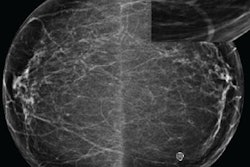
Using artificial intelligence (AI) software with digital breast tomosynthesis (DBT) shortens reading time and improves breast cancer detection, sensitivity, and specificity in both dense and nondense breasts, according to research presented April 4 at the Society of Breast Imaging (SBI) annual meeting in Hollywood, FL.
The findings mean the combination of DBT and AI could result in better outcomes for patients and increased efficiency for radiologists, presenter Dr. Emily Conant of the University of Pennsylvania in Philadelphia told AuntMinnie.com.
 Dr. Emily Conant from the University of Pennsylvania.
Dr. Emily Conant from the University of Pennsylvania.
"From the patient viewpoint, our findings mean more cancers found and less false-positive studies, and that's great," she said. "From the radiologist viewpoint, they mean efficiency gains by decreasing the reading time of DBT, which we know takes longer than the interpretation of digital mammography-alone screening cases."
Conant and colleagues investigated the impact of breast density on radiologists' reading performance and reading time when using AI software with DBT. For the study, 24 radiologists reviewed 260 DBT exams, including 65 cases with biopsy-proven malignancies and 65 biopsy-proven benign cases. The radiologists read all exams with and without the help of an AI algorithm, which identified suspicious soft tissue and calcifications in DBT slices.
The researchers measured reader performance using area under the receiver operating characteristic curve (AUC) for distinguishing between malignant and benign cases and for assessing reading time with and without AI. They also assessed sensitivity and specificity. These performance endpoints were evaluated in the context of breast tissue categorized as either dense or nondense.
The use of AI improved the AUC for both dense and nondense breast tissue, Conant and colleagues found. It also shortened reading time, and improved sensitivity and specificity.
| Impact of AI on DBT performance in dense breast tissue | ||
| Performance measure | Without AI | With AI |
| AUC | ||
| Dense breasts | 0.81 | 0.87 |
| Nondense breasts | 0.78 | 0.84 |
| Reading time (seconds) | ||
| Dense breasts | 65.8 | 28 |
| Nondense breasts | 62.5 | 32.8 |
| Sensitivity | ||
| Dense breasts | 77% | 84% |
| Nondense breasts | 77% | 86% |
| Specificity | ||
| Dense breasts | 66% | 75% |
| Nondense breasts | 60% | 64% |
In previous research, Conant and colleagues showed that using AI software while reading DBT screening studies decreased radiologist reading time while maintaining -- if not improving -- accuracy, compared with reading the cases without it, Conant said. These study results go a step further, she noted.
"This study shows that improvements in reading time and accuracy are seen in both dense and nondense breasts when DBT cases are read with AI," she told AuntMinnie.com.
What's next? More feedback, Conant concluded.
"We definitely need more subanalyses of the data, and most importantly, continued translation and feedback as the AI system is incorporated into the clinical workplace," she said.




















